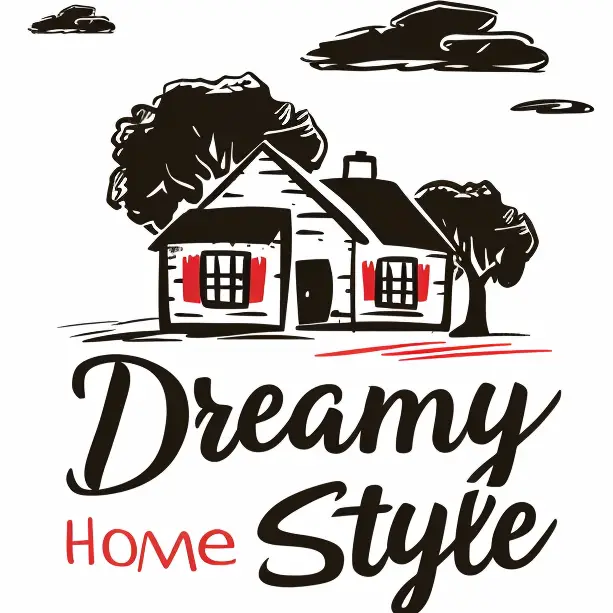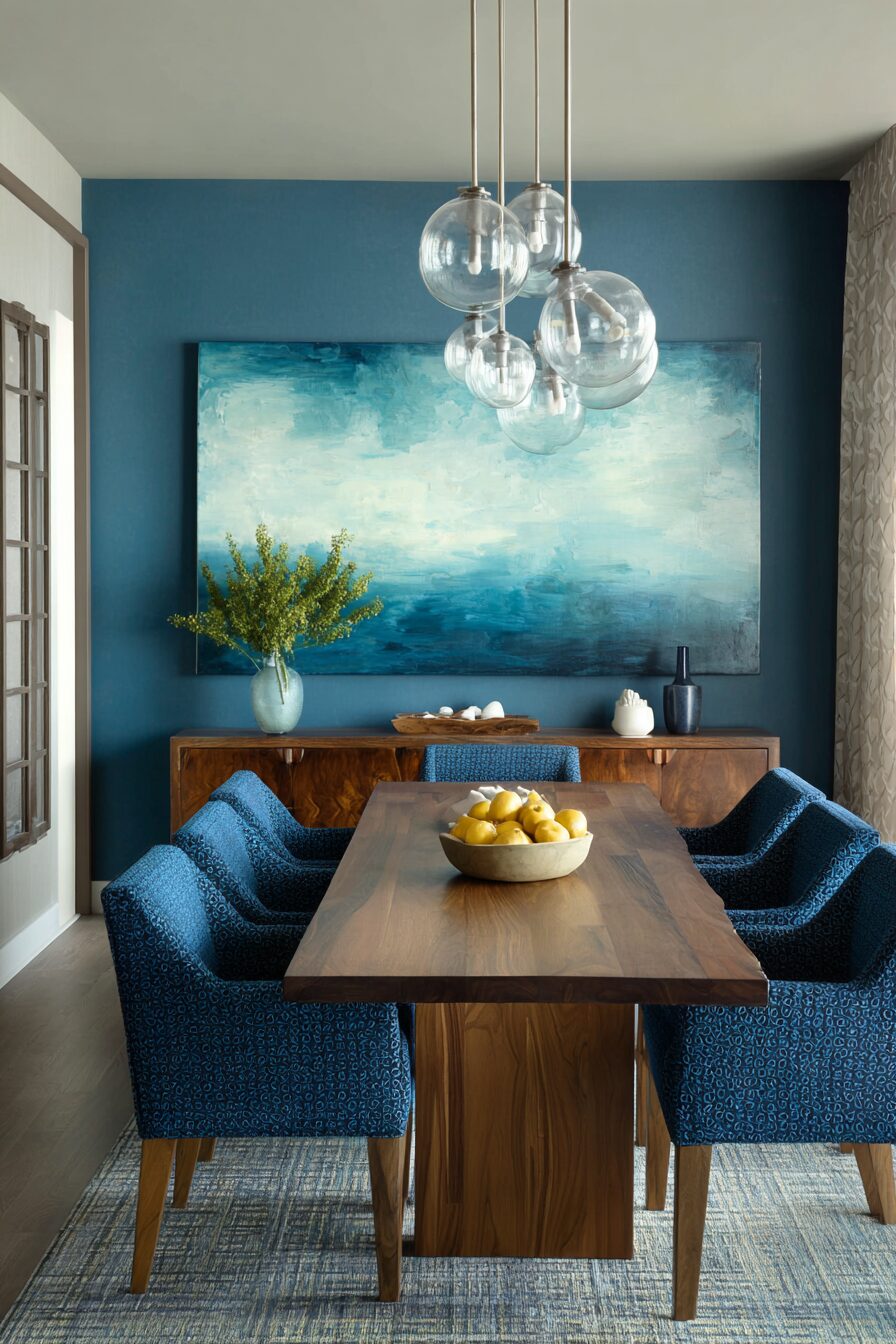Blue has this magical ability to make any space feel both calming and sophisticated, and your dining room is no exception.
If you’re dreaming of navy elegance or soft powder blue charm, these cozy blue dining room ideas will help you create a space that’s perfect for intimate family dinners and memorable gatherings with friends.
Embrace the Drama of Deep Navy Walls
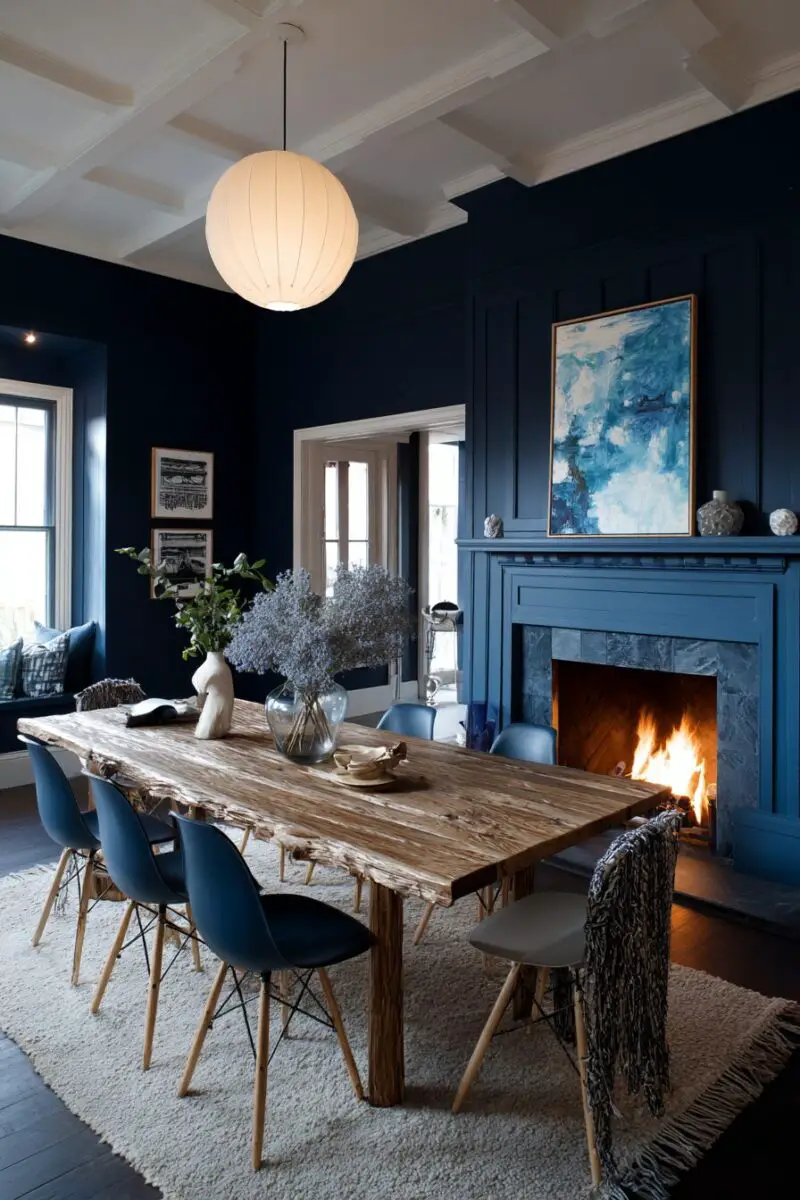
You’ve probably scrolled past countless white dining rooms, but nothing beats the cozy sophistication that deep navy walls bring to your space.
Navy creates an intimate cocoon effect that makes even the largest dining rooms feel welcoming and warm.
The key to pulling off this bold look is balancing the darkness with plenty of warm lighting and lighter accents.
Pair your navy walls with crisp white trim and molding to create stunning contrast that prevents the room from feeling too heavy.
Brass or gold light fixtures work beautifully against navy, adding that warm metallic glow that makes the space feel luxurious rather than cave-like.
You’ll want to incorporate plenty of texture through your dining chairs, whether that’s a plush velvet upholstery or woven natural fibers that add visual interest.
A large mirror with an ornate frame can work wonders in reflecting light around the room and making the space feel more open.
Don’t forget about your ceiling – painting it a lighter shade of blue or keeping it white will prevent the room from feeling too enclosed.
Window treatments in lighter fabrics like linen or silk can soften the dramatic walls while still maintaining that cozy atmosphere you’re after.
The beauty of navy is that it works with almost any wood tone, from light oak to rich walnut, giving you flexibility in choosing your dining table and other furniture pieces.
Adding plants brings life to the space and creates a beautiful contrast against the deep blue backdrop.
Incorporate artwork with warm tones like coral, cream, or gold to create visual warmth against the cool blue walls.
Table linens in neutral tones or warm whites will pop beautifully against the navy backdrop during dinner parties.
The result is a dining room that feels like an elegant retreat where conversations flow as smoothly as the wine.
Madison’s Current Obsessions
11+ Ultimate Chill Room Ideas for Your Cozy HideawayCreate Coastal Charm with Soft Powder Blue
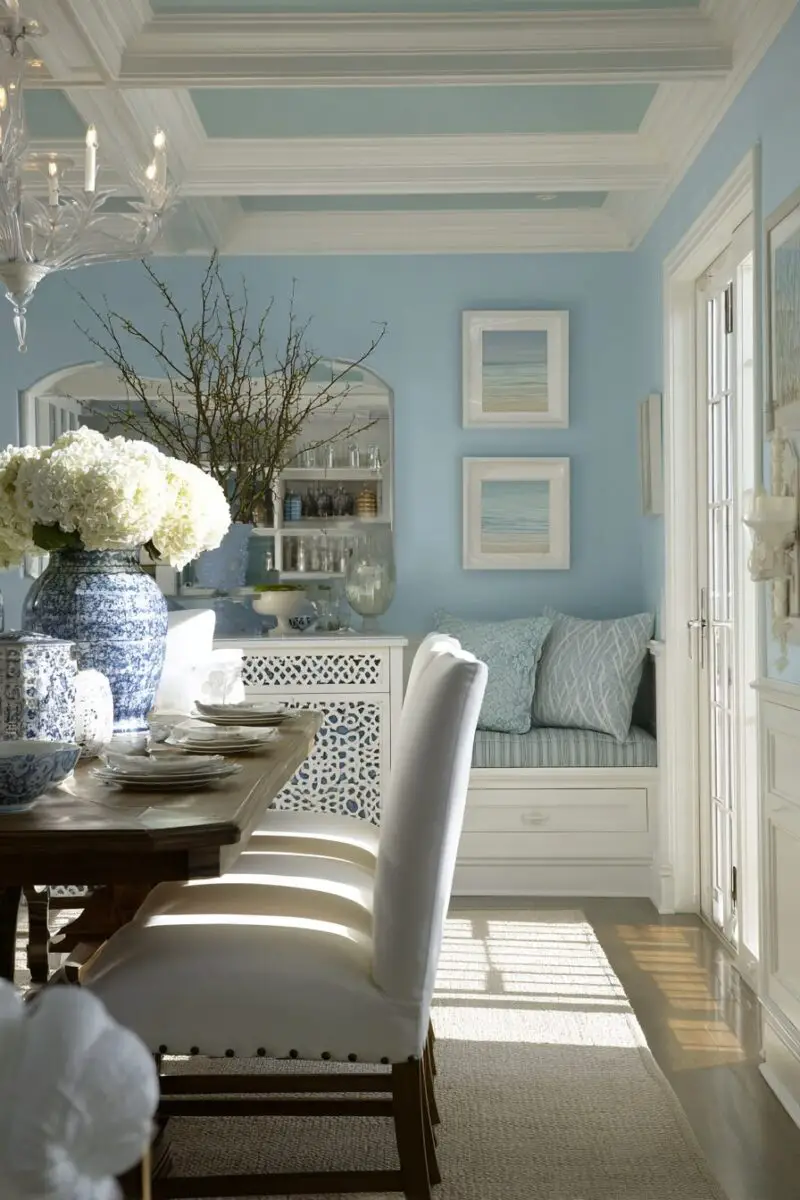
Powder blue walls instantly transport you to a breezy coastal cottage, making every meal feel like a seaside vacation.
This gentle shade works particularly well in dining rooms that receive plenty of natural light, as it amplifies that airy, open feeling.
The secret to nailing the coastal look is layering different shades of blue throughout the space without making it feel overwhelming.
Start with powder blue on the walls, then introduce deeper blues through your dining chair cushions or a statement area rug.
White or cream-colored furniture creates the perfect contrast and prevents the space from feeling too monochromatic.
Wicker or rattan dining chairs add that essential coastal texture while maintaining the relaxed, casual vibe you’re going for.
Natural wood elements like a reclaimed dining table or floating shelves bring warmth and prevent the space from feeling too cool.
Incorporate nautical touches subtly – think rope details on light fixtures or seashell collections displayed on open shelving.
Linen curtains in white or natural tones will flutter beautifully in the breeze and enhance that beachy, relaxed atmosphere.
The key is keeping the overall palette light and airy while adding interest through different textures and natural materials.
Add a jute or sisal rug underneath your dining table to ground the space and add that essential coastal texture.
Fresh flowers in white or soft yellow create beautiful pops of color without competing with your blue color scheme.
Table settings in white ceramics or natural wood complement the coastal theme perfectly and make every meal feel special.
Artwork featuring seascapes or abstract pieces in complementary blues and whites can tie the whole look together.
The result is a dining room that feels like a permanent vacation spot where stress melts away with every meal.
Design Your Dream Room in Minutes! By DreamyHomeStyle
🏡 Start Creating FREE →Madison’s Current Obsessions
Why Your Bedroom Deserves A Grown Woman Makeover Right Now!Mix Blue and White Stripes for Timeless Appeal
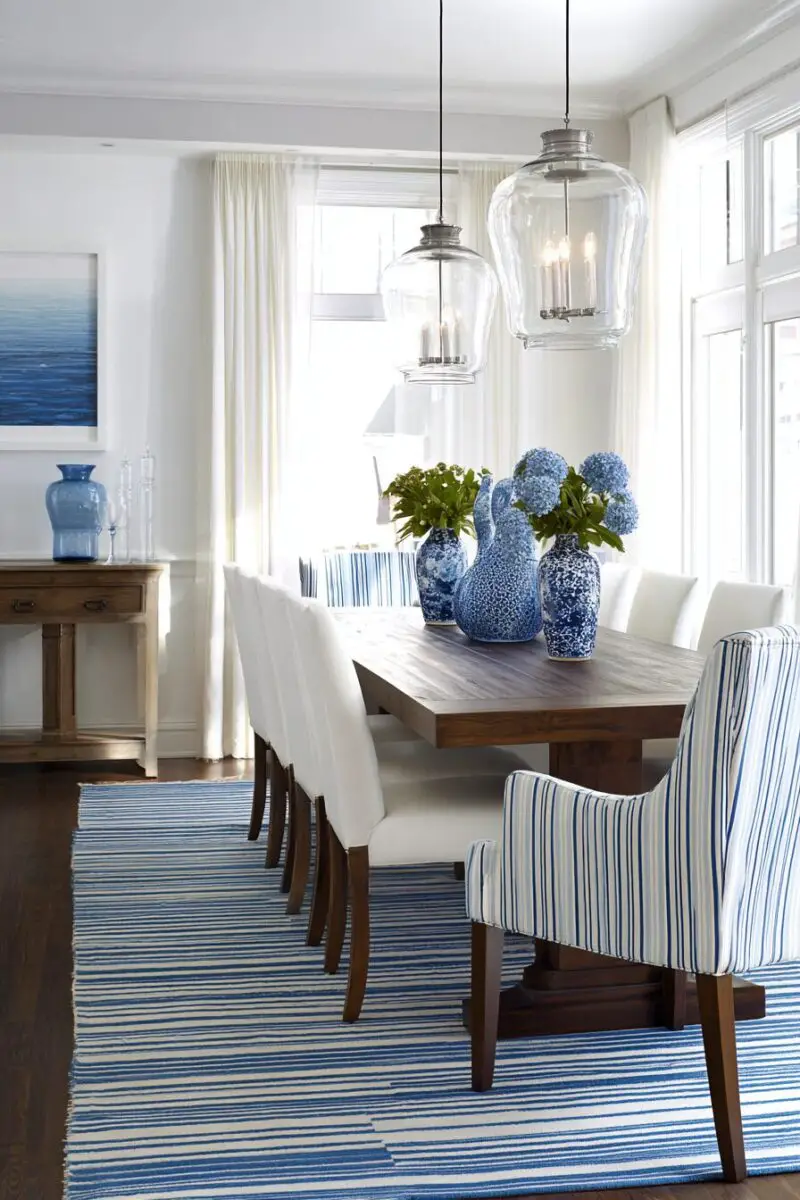
Nothing says classic coastal elegance quite like blue and white stripes, and incorporating this pattern into your dining room creates instant visual interest.
Striped wallpaper on an accent wall becomes a stunning focal point that draws the eye and creates depth in your space.
The beauty of stripes is their versatility – thin pinstripes create a subtle, sophisticated look while broader stripes make a bold statement.
You can introduce stripes through wallpaper, but don’t overlook other opportunities like striped dining chair cushions or table runners.
The key to keeping striped patterns from overwhelming your space is balancing them with solid colors and simple, clean lines.
Choose furniture with classic silhouettes that won’t compete with the pattern – think Windsor chairs or a simple farmhouse table.
Metallic accents in brass or pewter add sophistication without clashing with the nautical-inspired pattern.
If you’re hesitant about committing to striped walls, start smaller with striped curtains or a large area rug under your dining table.
The direction of your stripes matters too – vertical stripes can make ceilings appear higher, while horizontal stripes can make narrow rooms feel wider.
Incorporating natural elements like a wooden chandelier or woven placemats helps soften the graphic nature of the stripes.
Layer in solid blue accessories like ceramic vases or linen napkins to tie the color scheme together without adding more pattern.
The trick is keeping your other patterns minimal – if you have striped walls, stick to solid or very subtle textures elsewhere.
Lighting plays a crucial role in making stripes work – avoid harsh overhead lighting that can make the pattern feel too busy.
Instead, opt for warm, ambient lighting from table lamps or sconces that create a cozy glow.
The end result is a dining room that feels both classic and fresh, with enough visual interest to keep conversations flowing.
Madison’s Current Obsessions
Top 15 Nature Bedroom Ideas to Bring the Outdoors InIncorporate Vintage Blue China for Elegant Character
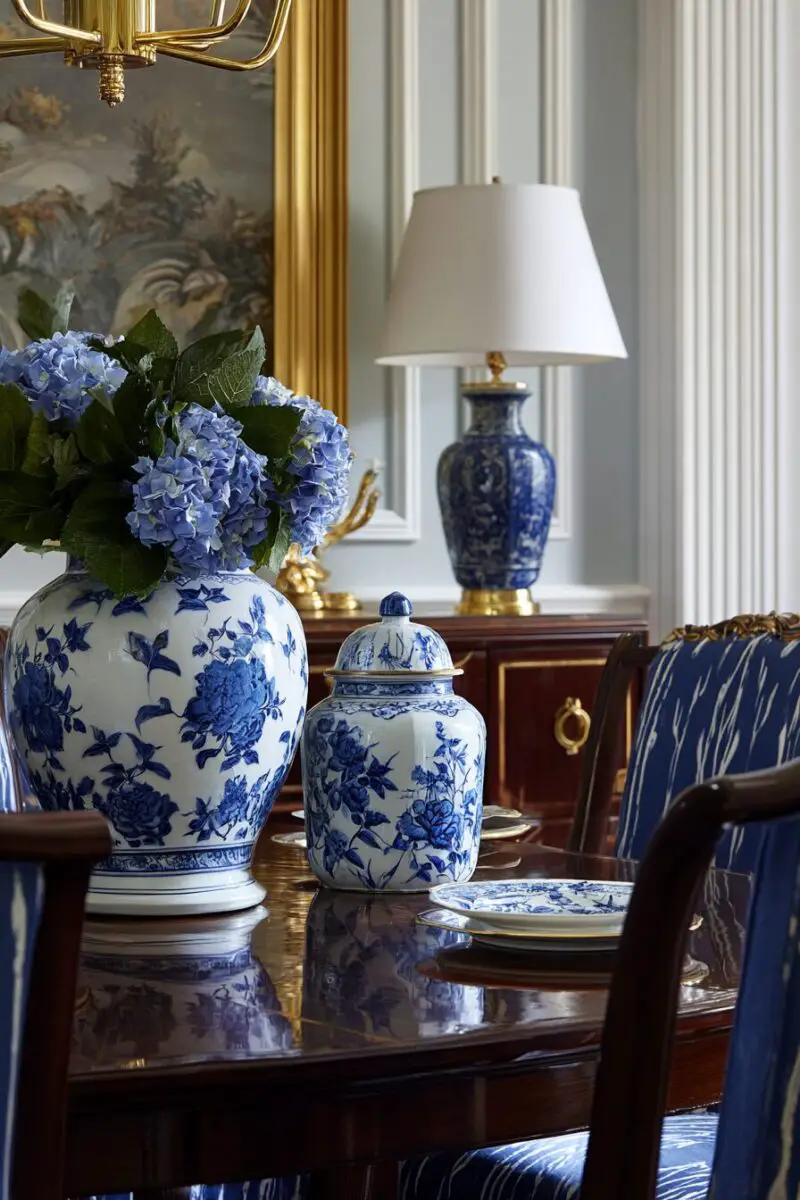
Your grandmother’s blue china collection doesn’t have to stay hidden in storage – displaying it can become the foundation for an incredibly charming dining room design.
Blue and white porcelain instantly adds character and history to your space, creating conversation starters that store-bought decor simply can’t match.
The beauty of building your design around vintage china is that each piece tells a story and adds layers of visual interest.
Open shelving or a beautiful china cabinet becomes both storage and display, turning your collection into living art.
You don’t need a complete matching set – mixing different patterns and shades of blue creates an eclectic, collected-over-time look that feels authentic.
Paint your walls in a complementary soft blue or keep them neutral to let your china collection be the star of the show.
Incorporate the same blue tones from your china into other elements like chair cushions or table linens for a cohesive look.
The key is displaying your pieces at varying heights and depths to create visual interest rather than a museum-like feeling.
Mixing your vintage blue pieces with modern white dishes creates a beautiful contrast between old and new.
Don’t forget about functional display – use cake stands, tiered servers, and decorative bowls as both storage and decoration.
Incorporating plants or fresh flowers in white or cream vases scattered throughout your china display adds life and softness.
The patina and slight imperfections of vintage pieces add character that new items can’t replicate, making your dining room feel collected and curated.
Proper lighting is essential for showcasing your collection – cabinet lighting or strategically placed spotlights can make your pieces truly shine.
The result is a dining room that feels like it has a story to tell, where every meal is surrounded by beautiful, meaningful objects.
Madison’s Current Obsessions
Top 12 Granola Dorm Room Ideas: Create Your Eco-Chic SpaceAdd Blue Velvet Dining Chairs for Luxurious Comfort
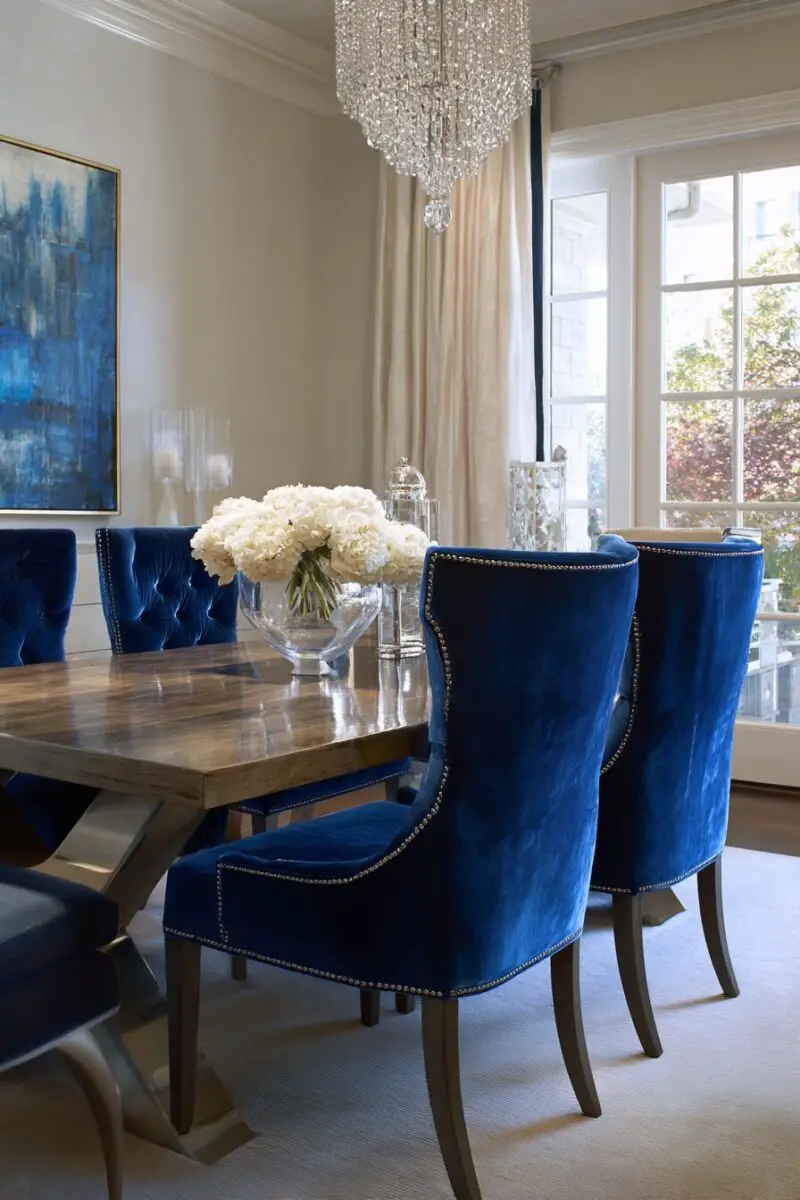
Nothing elevates a dining room quite like the rich texture and deep color of blue velvet dining chairs.
The luxurious fabric instantly transforms even the most basic dining table into an elegant focal point that commands attention.
Velvet has this amazing ability to look different throughout the day as natural light shifts, creating depth and interest that changes with the hours.
The key to incorporating velvet chairs successfully is choosing the right shade of blue for your space and existing decor.
Deep navy velvet creates drama and sophistication, while lighter blues feel more approachable and casual.
Velvet chairs work beautifully with both traditional and modern dining tables, bridging different style periods effortlessly.
The texture contrast between smooth wood or metal tables and plush velvet seating creates visual and tactile interest.
Mix velvet chairs with other seating options like a velvet bench on one side of the table for added versatility.
The beauty of velvet is how it catches and reflects light, adding richness to your dining room that other fabrics simply can’t achieve.
Maintenance might seem daunting, but quality velvet is surprisingly durable and many modern options are treated for stain resistance.
Pairing blue velvet chairs with metallic accents like brass or copper creates a sophisticated color palette that feels both classic and contemporary.
The chairs become conversation pieces themselves, encouraging guests to linger longer around your table.
Adding throw pillows in complementary colors or patterns can customize the look and add extra comfort for longer dinner parties.
The result is a dining room that feels like fine dining every night, where the simple act of sitting down to eat becomes a luxurious experience.
Madison’s Current Obsessions
Why A Neutral And Black Bedroom Could Be Your New Favorite Escape!Design a Blue and White Farmhouse Haven
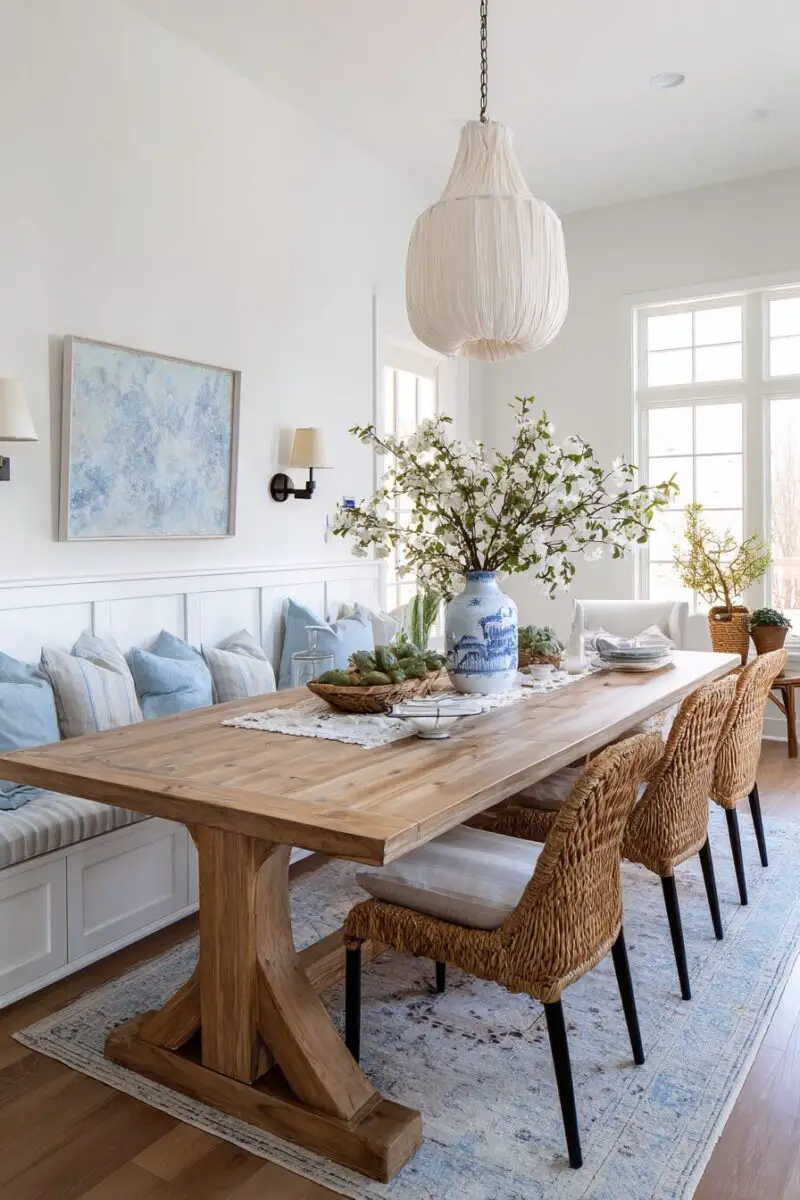
The combination of blue and white in a farmhouse setting creates the perfect balance between rustic charm and refined elegance.
This color palette works beautifully with the natural textures and materials that define farmhouse style, from reclaimed wood to vintage metals.
Start with white or cream walls as your base, then introduce blue through carefully chosen accents and furniture pieces.
A weathered blue dining table becomes the heart of the space, telling stories of family gatherings and home-cooked meals.
The beauty of farmhouse blue lies in its imperfect, lived-in quality – think milk paint finishes and gentle distressing.
Incorporate blue through vintage-inspired pieces like a painted hutch or collection of blue mason jars displayed on open shelving.
Natural wood elements like exposed beams or a reclaimed wood accent wall add warmth and prevent the space from feeling too precious.
The key is layering different textures – smooth painted surfaces, rough wood, woven baskets, and vintage textiles all work together.
Blue and white checked or gingham patterns can be introduced through cushions, curtains, or table linens for authentic farmhouse charm.
Vintage lighting fixtures like mason jar pendants or a wrought iron chandelier complete the look while providing practical illumination.
Fresh flowers in simple blue and white vessels add life and color while maintaining the unpretentious farmhouse aesthetic.
The goal is creating a space that feels collected over time rather than decorated all at once, with pieces that have character and history.
Incorporating functional elements like a vintage blue colander used as a fruit bowl adds charm while serving a purpose.
The result is a dining room that feels like the heart of a country home, where every meal is a celebration of simple pleasures.
This style works particularly well in homes with architectural features like shiplap walls or wide-plank floors that enhance the farmhouse aesthetic.
Madison’s Current Obsessions
13 Trendy Street Style BedRoom Ideas for an Urban LookUse Blue Wallpaper with Botanical Prints
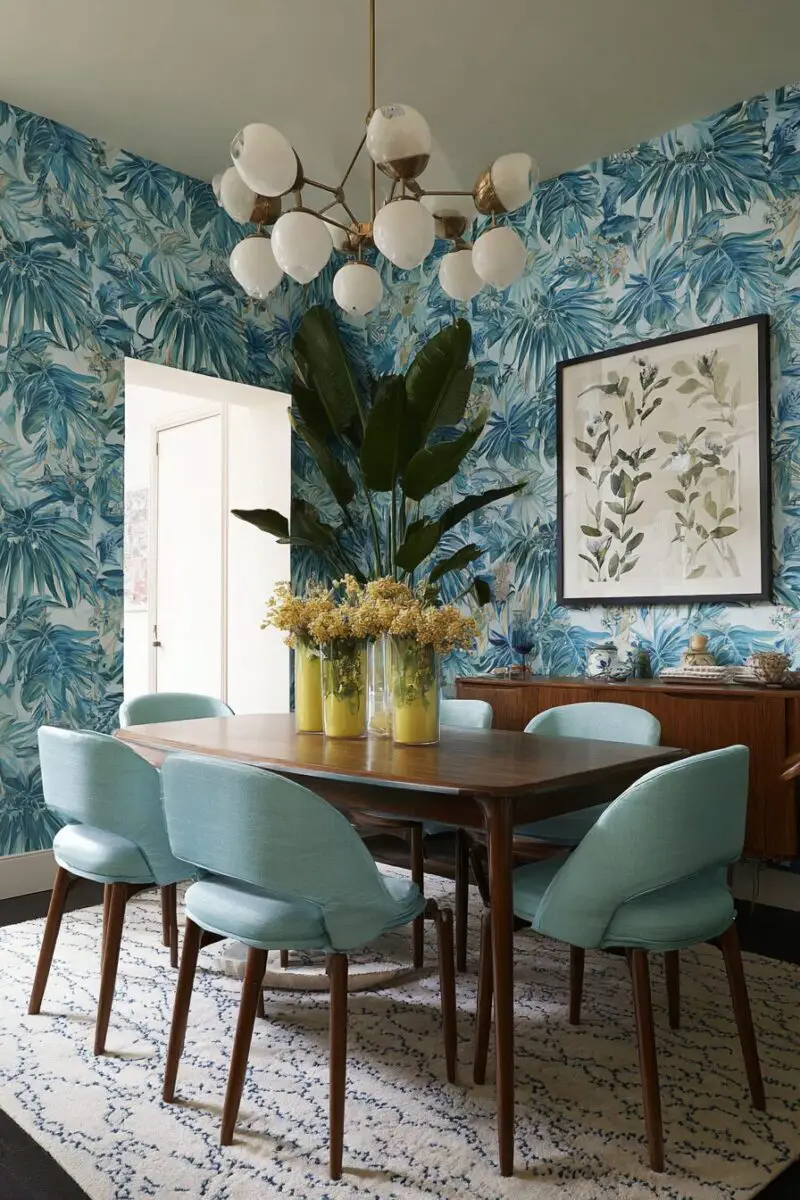
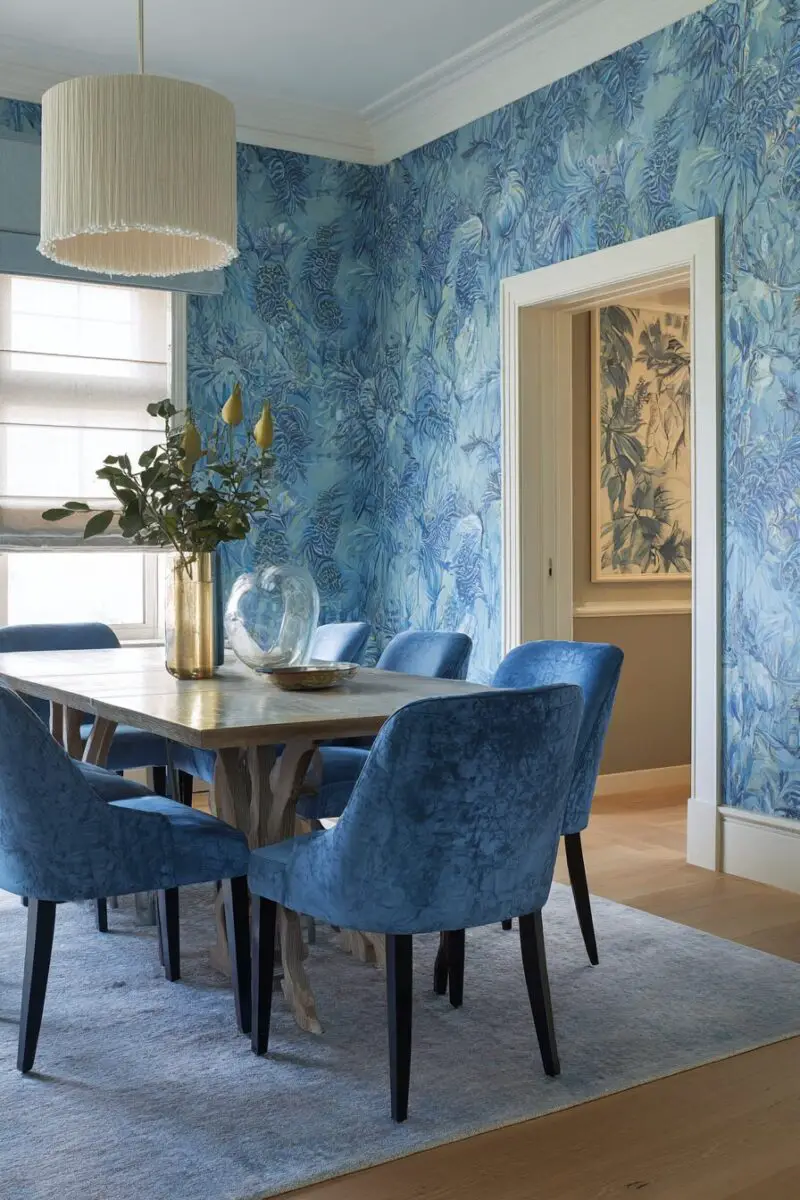
Botanical wallpaper in blue tones brings the beauty of nature indoors while creating a sophisticated, garden-inspired dining atmosphere.
The organic patterns and flowing lines of botanical prints soften the structured lines of dining furniture and create a more relaxed, natural feeling.
Blue botanical wallpaper works particularly well as an accent wall behind a buffet or china cabinet, creating a beautiful backdrop for displaying dishes and decor.
The key is choosing prints that complement rather than compete with your existing furniture and accessories.
Larger scale botanical prints work well in spacious dining rooms, while smaller, more delicate patterns suit intimate spaces better.
The various shades of blue found in botanical prints allow you to pull accent colors throughout the room for a cohesive look.
Pairing botanical wallpaper with natural wood furniture enhances the garden theme and creates a harmonious, organic feeling.
The beauty of botanical patterns is their timeless appeal – they never go out of style and work with both traditional and contemporary furnishings.
Incorporate live plants throughout the space to echo the botanical theme and add fresh air and natural beauty.
The patterns in botanical wallpaper create visual interest without being overwhelming, making them perfect for spaces where you spend extended time.
Complement the wallpaper with table linens and accessories that pick up the blue tones without competing with the pattern.
The result is a dining room that feels like an elegant conservatory, where meals are enjoyed surrounded by the beauty of nature.
This approach works especially well in homes with garden views, creating a seamless connection between indoor and outdoor spaces.
Madison’s Current Obsessions
Bedroom Wall Decor Mistakes Everyone Makes (And How to Avoid Them)!Create Depth with Blue Wainscoting
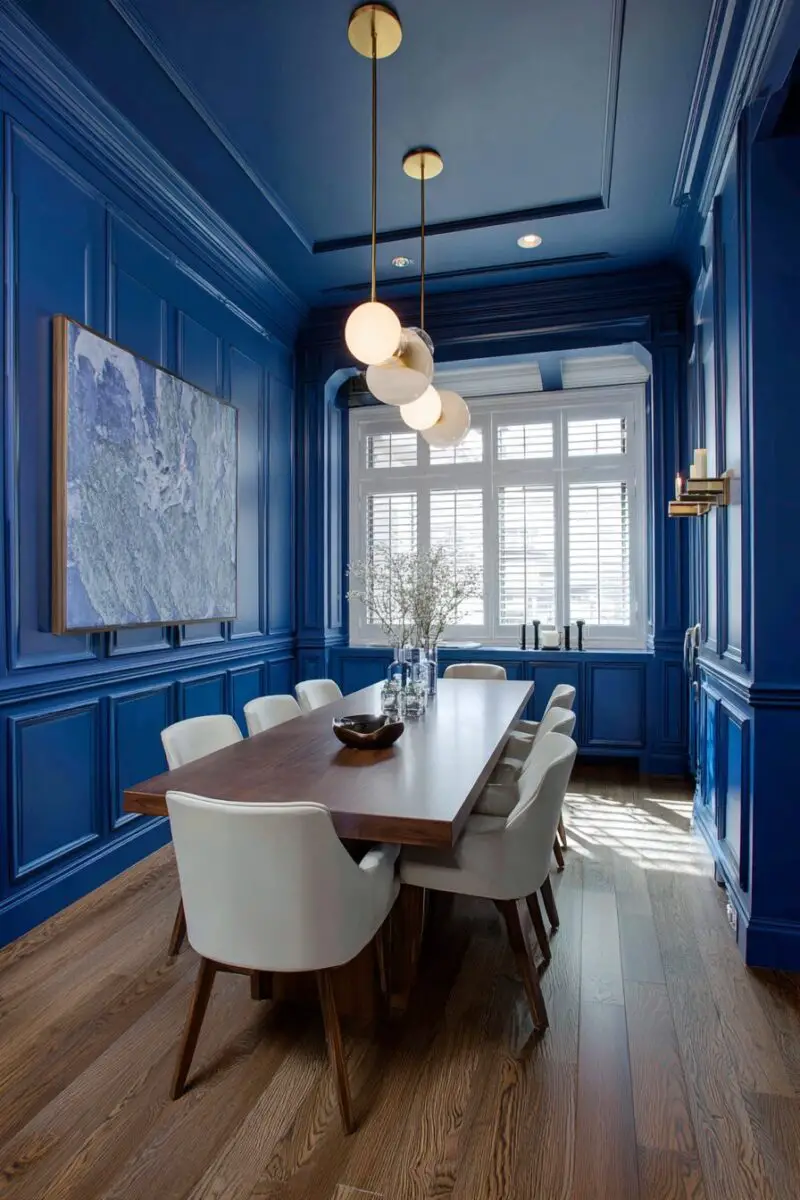
Blue wainscoting adds architectural interest and visual depth to your dining room while creating a sophisticated two-tone effect that’s both classic and fresh.
This traditional wall treatment brings instant character to plain walls and can make even new construction feel like it has historical charm.
The beauty of wainscoting lies in its ability to add texture and dimension without overwhelming the space with pattern or bold colors.
Choosing the right shade of blue for your wainscoting sets the tone for the entire room – deeper blues feel more formal while lighter shades are more casual.
The contrast between the blue wainscoting and white or cream upper walls creates visual interest while maintaining a sense of balance.
Wainscoting naturally draws the eye horizontally around the room, making spaces feel wider and more expansive.
The height of your wainscoting matters – traditional chair rail height (around 36 inches) works in most dining rooms, but taller wainscoting can make rooms feel more dramatic.
This treatment works beautifully with both painted and natural wood finishes on the upper portion of the walls.
The blue wainscoting provides a beautiful backdrop for artwork hung on the upper white portion of the walls.
Incorporating a chair rail in a contrasting color like white or natural wood adds another layer of architectural detail.
The practical benefits include protecting your walls from chair backs and daily wear while adding insulation and sound absorption.
Lighting considerations are important – wainscoting looks beautiful with both overhead lighting and wall sconces mounted on the upper white portion.
The result is a dining room with classic architectural character that feels both timeless and fresh, where the walls themselves become a design feature.
This treatment works particularly well in traditional and transitional homes but can also add character to more contemporary spaces.
Madison’s Current Obsessions
13 Unique Bedroom Wall Collage Ideas To Inspire YouLayer Different Shades of Blue for Visual Interest

Creating a monochromatic blue palette doesn’t mean boring – layering different shades and tones creates incredible depth and sophistication in your dining space.
The key to successful blue layering is understanding the undertones in different blues and how they work together harmoniously.
Start with a base blue for your largest elements like walls or a large area rug, then build up with varying shades in smaller accessories.
Mixing warm blues (those with gray or green undertones) with cool blues (those with purple undertones) creates natural contrast and prevents the space from feeling flat.
The beauty of a monochromatic scheme is its inherent calm and cohesion – everything works together effortlessly.
Texture becomes crucial when working with similar colors – smooth painted surfaces, rough textiles, shiny metals, and matte finishes all reflect light differently.
Put the natural light in your space throughout the day, as different blues can shift dramatically from morning to evening.
Incorporate white or cream as a neutral anchor prevents the space from feeling overwhelming and gives the eye a place to rest.
The 60-30-10 rule works well here – use your lightest blue for 60% of the space, medium blue for 30%, and darkest blue for 10% in accents.
Metallic accents in silver, pewter, or brass add warmth and prevent the cool blue palette from feeling too cold.
Different finishes on similar blue tones create subtle variation – think matte paint next to glossy ceramics or polished metal.
The goal is creating movement and interest while maintaining the peaceful, cohesive feeling that makes monochromatic schemes so appealing.
Artwork and accessories in varying blue tones can be switched out seasonally to refresh the look without major changes.
The result is a sophisticated, calming dining room where every element works in harmony to create a truly restful and elegant space.
This approach works particularly well in homes with open floor plans, as the cohesive color scheme helps define the dining area without walls.
Madison’s Current Obsessions
13 Dark Green And Black Bedroom Ideas To EnvyFinish with Blue Ceramic and Glass Accessories
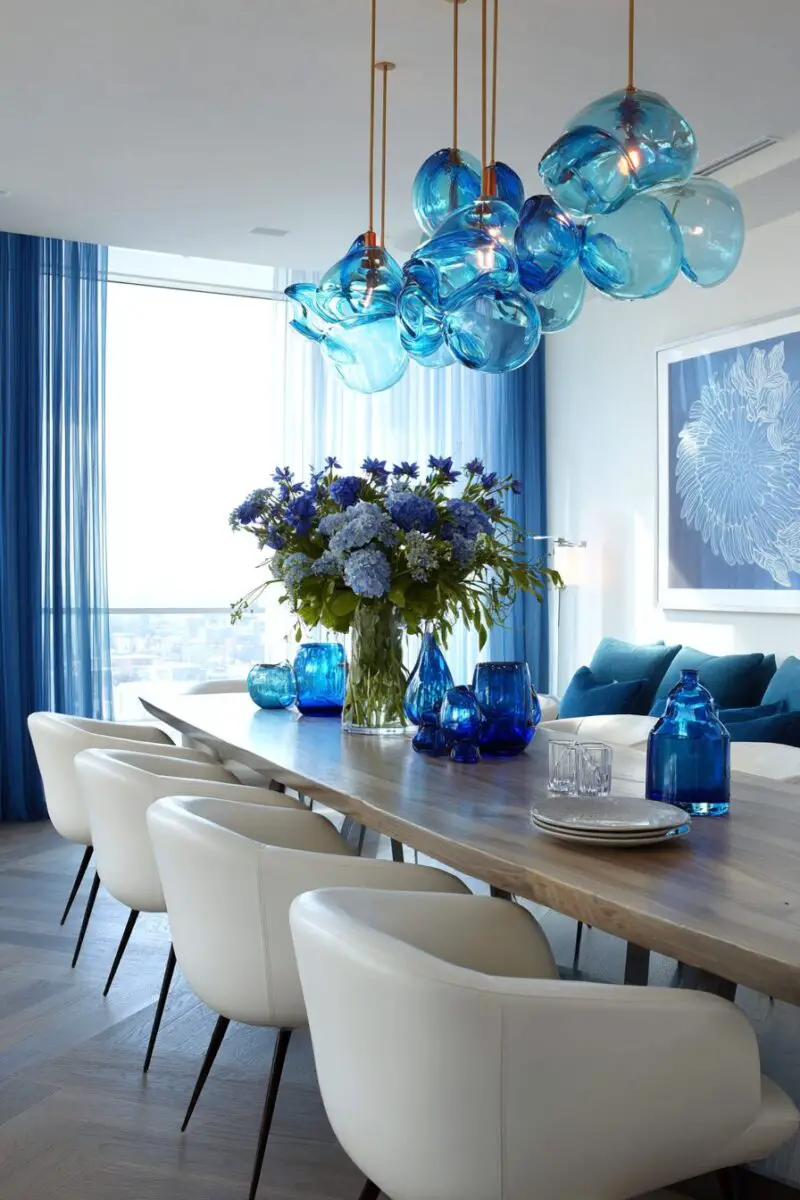
The finishing touches make all the difference, and blue ceramic and glass accessories can tie your entire dining room design together beautifully.
These pieces add color, texture, and personality while serving practical purposes for dining and entertaining.
The beauty of ceramic and glass pieces lies in their ability to catch and reflect light, adding sparkle and life to your dining space.
Start with a few statement pieces like a large blue ceramic vase or glass bowl, then build your collection over time.
Mixing different textures within the same color family creates visual interest – think smooth glazed ceramics with textured glass pieces.
The varying shades of blue found in handmade ceramics and blown glass add depth and authenticity to your color scheme.
Consider both functional and decorative pieces – blue ceramic serving dishes, glass water pitchers, and decorative bowls all serve dual purposes.
The placement of these accessories matters as much as the pieces themselves – group items in odd numbers and vary heights for visual appeal.
Incorporating pieces with different finishes like matte, glossy, and crackle glazes adds texture and prevents the display from looking too uniform.
The transparency of blue glass pieces allows light to pass through, creating beautiful color effects especially near windows.
Mix vintage and contemporary pieces to create a collected-over-time look that feels authentic rather than decorated.
Consider the scale of your accessories in relation to your furniture – larger tables can handle bigger statement pieces while smaller spaces need more delicate items.
Seasonal changes are easy with accessories – switch out pieces or add fresh flowers in blue vases to refresh the look.
The result is a dining room that feels complete and personal, where every carefully chosen piece contributes to the overall atmosphere and beauty of the space.
These final touches transform a good dining room into a great one, where guests feel welcomed and meals become memorable experiences.
Creating a cozy blue dining room is all about finding the right balance of color, texture, and personal style that makes you want to linger over every meal.
If you choose dramatic navy walls or soft powder blue accents, these ideas will help you create a space that’s both beautiful and inviting for years to come.
